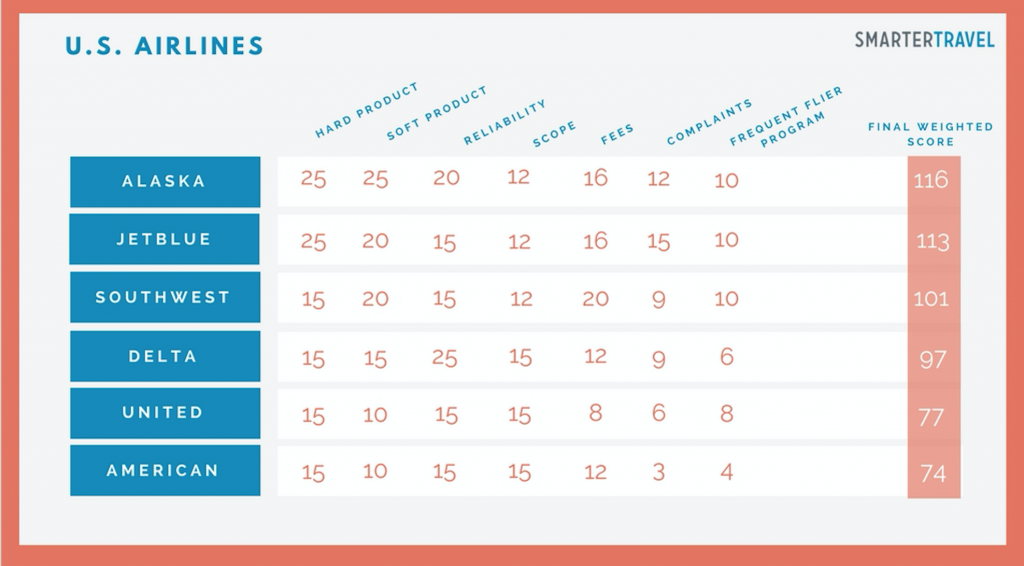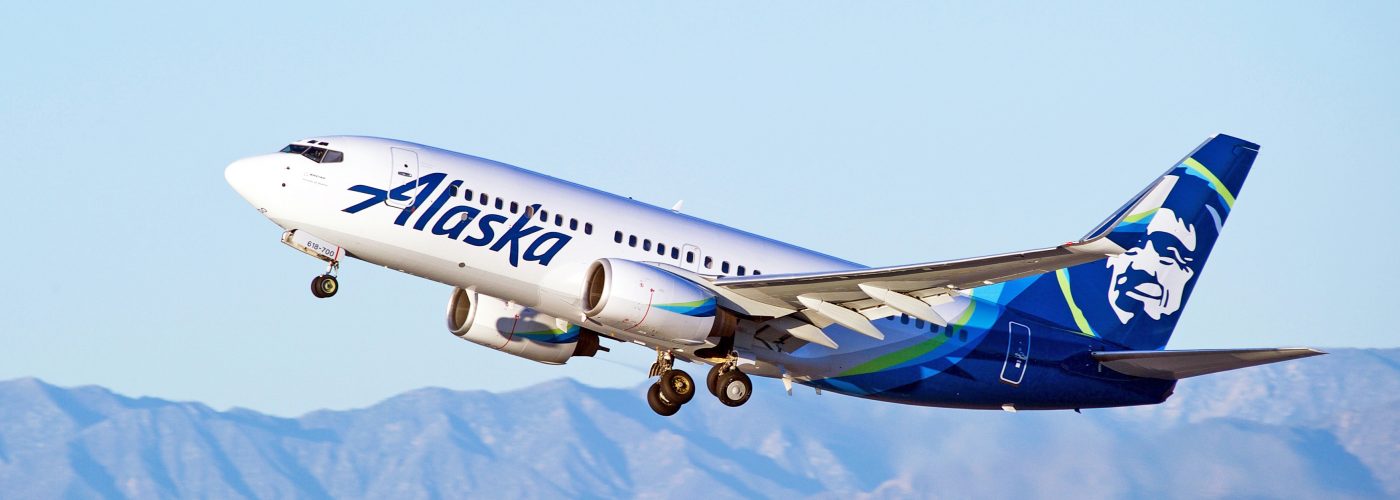Then it could be claimed that the most important part of any trip is the flight if travel is about the trip. So when we set out to ascertain our Editor’s Choice award in the category of Best U.S. Airline for 2017 we believed that the crucial things that are likely to affect the average traveler: reliability, fees, legroom, seat width, number of paths, and other components that contribute to overall satisfaction. But what of U.S. airline came out on top?
To arrive at a winner, we rated the coach/economy product for the six largest U.S. airlines: Alaska, American, Delta, JetBlue, Southwest, and United. We excluded Spirit and Frontier since we knew, going in, that neither will come near a top score according to our criteria. We excluded Sun Country, and Allegiant, Hawaiian because of their coverage of special markets, and we excluded Virgin America because of its merger with Alaska.
Two airlines came out even, with the winner edging the runner up by three points in our score.
Best Domestic Airline for 2017: The Methodology
We rated the six candidates on the grounds of seven variables, as graded on a scale of 1-5 to get a series of components in each variable. We then weighted the variables on a scale to calculate scores
- Hard product: Legroom, seat thickness, audiovisual entertainment systems, at-seat energy availability, and also the airline’s “stretched market” alternative.
- Soft product: How nicely the traveling public likes the experience.
- Reliability: How nicely the airline works as it claims.
- Scope: How far and to just how many areas it can take you.
- Fees: How badly it gouges you for the extras.
- Complaints. Many travelers are irked enough to complain to the Department of Transportation.
- Frequent flyer program: How useful the program is to the typical leisure traveler.
Best Domestic Airline for 2017: The Winner
Alaska is your top U.S. airline for domestic coach travel for 2017. It scored at or near the top in the majority of the ratings category and badly in none.
We viewed domestic airlines throughout the lens of scoring how well each airline is likely to serve leisure travelers and infrequent business travelers within coach/economy class for travel within the U.S. and to nearby Canadian, Mexican, and island points. Intercontinental travel is a very different arena, necessitating different methods. And frequent “road warrior” business travelers are an entirely different traveler group, lots of whom travel in patterns dictated by company policy.

Alaska scored best for the aspects that matter most to ordinary travelers: its hard product and soft merchandise are at or near the top; it costs for checked bags and ticket fluctuations, but its fees aren’t as outrageous as people around the most other U.S. airlines; its own frequent flyer program keeps some exceptionally useful partners and still foundations earned charge on miles flown, a large plus for infrequent travelers; it scores well for complaints and reliability; and though it’s largely a domestic airline, Alaska’s partnerships with other important airlines around the world provide it worldwide extent.
Best Domestic Airline for 2017: Other Finalists
Studies indicate that when travelers are arranging a trip, fare and schedule trump “quality” variables each moment. Accordingly, those quality factors are in the nature of tie-breakers, plus they come into play only once you’ve got a choice of lines at similar fares and schedules. Even the greatest airline is irrelevant if it doesn’t go where you desire.
Thus, there’s no potential “one size fits all” award. Three clear “honorable mention” awards surfaced, some of which might well be your first choice in which Alaska doesn’t fly:
- JetBlue did well across the board, especially for its simple high-payback frequent flyer program and also undoubtedly the best hard product in its own “cultivated market” cabins. Unfortunately, JetBlue is in the process of downgrading its product, so its appeal is very likely to decrease in future years.
- Delta earned the best scores one of the three giant community lines, reaching the top for scope and performing as well as or better than its peers on most other facets. For the time being, it seems to be outdoing American and United, which both can be playing with a catch-up game.
- Southwest is the runaway winner for people who despise fees, also it provides a good hard product.
Best Domestic Airline for 2017: Added Methodological Details
Each of the seven rating factors consisted of several components. In all cases data were transformed to a 1-5 scale for computation of factor scores:
Hard product. Scores are based on seat pitch, seat thickness, availability and technical amount of inflight entertainment (IFE), accessibility of electricity ports, and also the excess space offered in the extended cabin, if available. All input was made together with width and pitch receiving weight. Weighting factor: 5.
Soft product. Scores are based on customer satisfaction and preference results from surveys released by AirLikes, SkyTrax, Wallet Hub, JD Power, as well as the American Customer Satisfaction Index (ACSI), together with numbers of complaints about poor service filed with the Department of Transportation, corrected for comparative carrier size. Factor: 5.
Reliability. Scores are based on printed Department of Transportation data covering on-time functionality, percentage of flights cancelled, numbers of mishandled bags, and involuntary bumping. Weighting factor: 5.
Scope. Scores are based on variety of airplanes, number of destinations, number of continents functioned, and extent of partnerships and alliances. Most data were obtained from airline websites. Factor: 3.
Fees. Scores are based on relative fees charged for the very first checked bag, second assessed luggage, a ticket shift, a one-way flight change, phone or broker booking, and also for unaccompanied minors. Fee data were extracted from SmarterTravel’s continuing fee tabulations. Fees for American, Delta, and United were based on prices for their principal coach/economy tickets, not the recently announced sub-economy fares. Weighting variable: 4.
Complaints. Scores are derived from Department of Transportation Consumer Reports. Factor: 3.
Frequent flyer program. Scores are based on ease of making and using credit, together with passenger survey reports printed by U.S. News and World Reports, Wallet Hub, IdeaWorks information on payback, IdeaWorks information on award seat availability, and analysis of point values. Variable: 2.
You may think we should have contained “fares” as a scoring category, but that actually isn’t feasible. Although you see some statistics on average fares, those numbers do not tell the whole story. The sole relevant fare amounts will be for cheapest available fares, corrected for stage length, and nobody generates these data. What’s more, it’s clear that most of the lines flying any route match each other for fare. The only exceptions are Frontier and Spirit, airlines that truly post minimal fares but add fees for almost every part of travel but the seat. Along with the giant lines have lately introduced minimal fare amounts to match those traces. None of the additional lines can be called ” low fare.”
We specifically excluded credit-card benefits, a completely different and extremely complex question which we address in another awards group. We also excluded fleet age for a figure that doesn’t translate directly into any differences which aren’t captured in the factors we did score.
